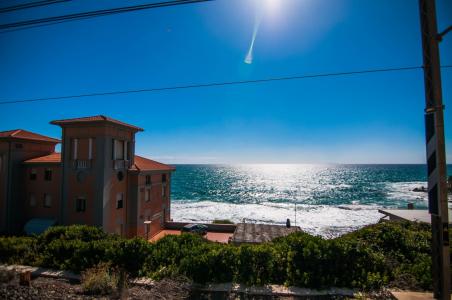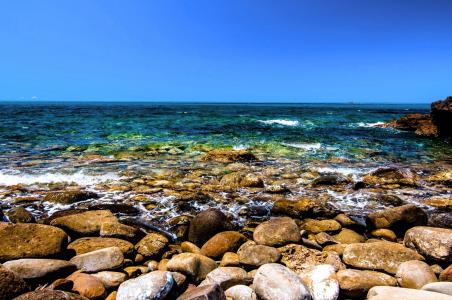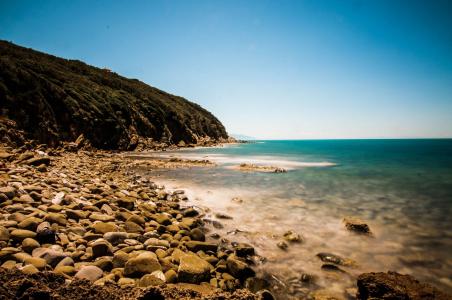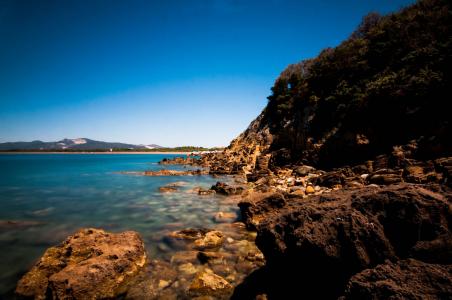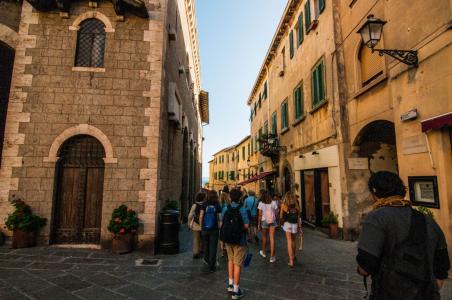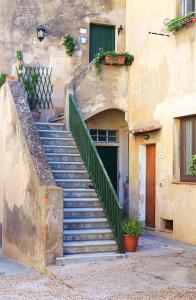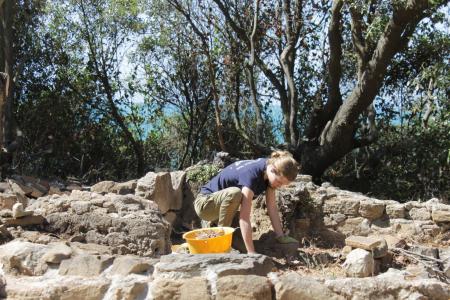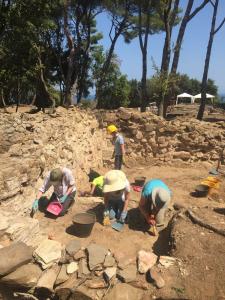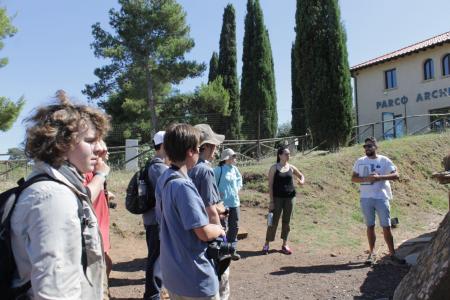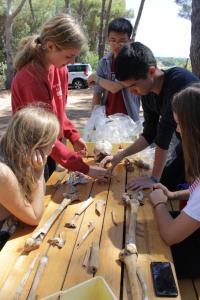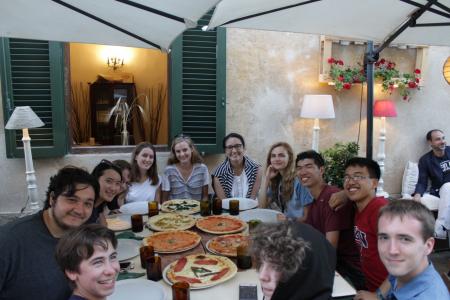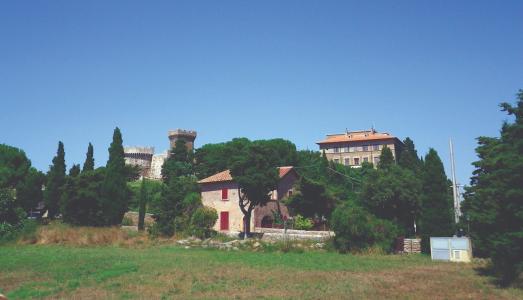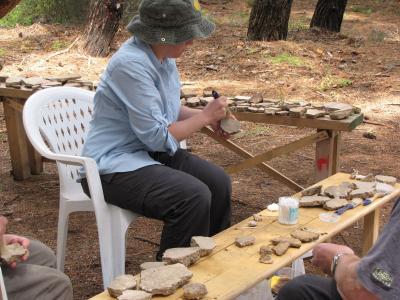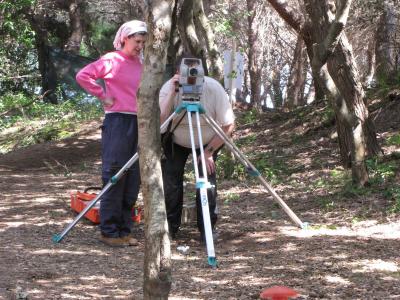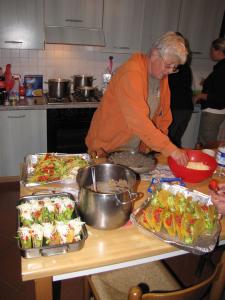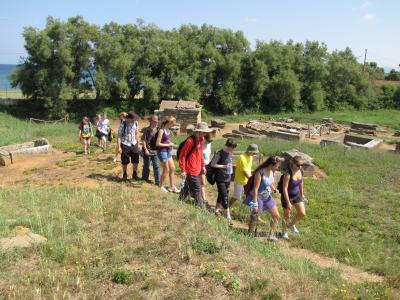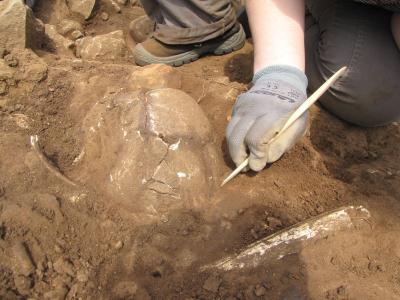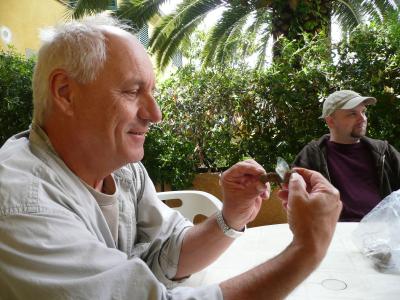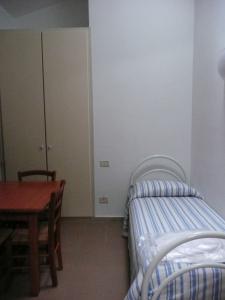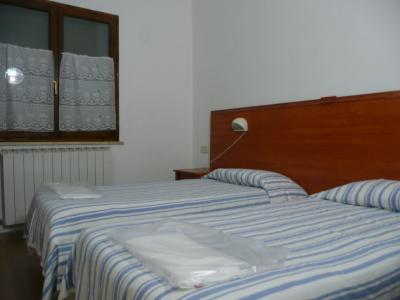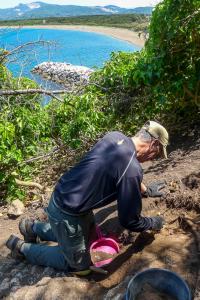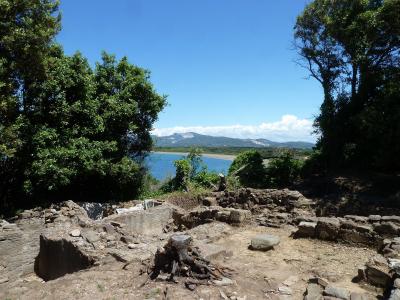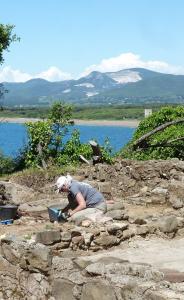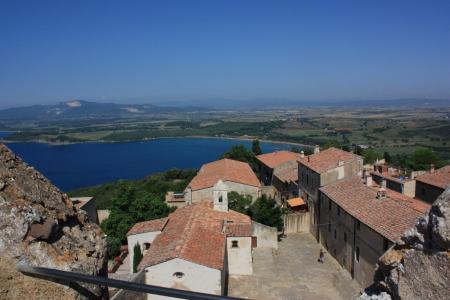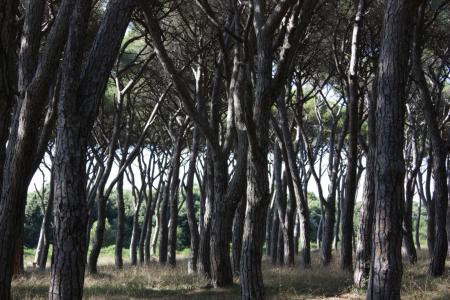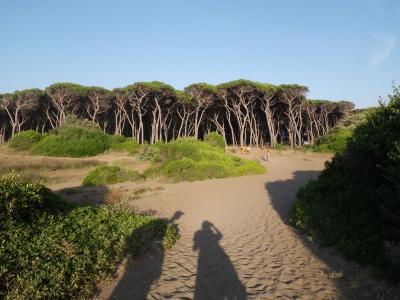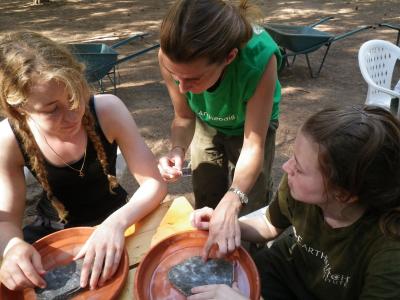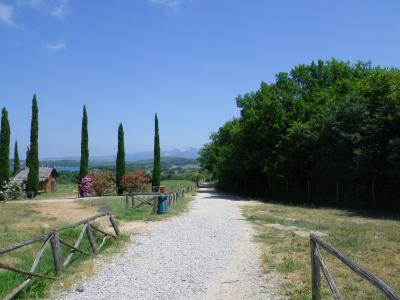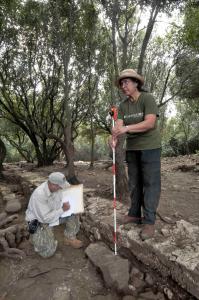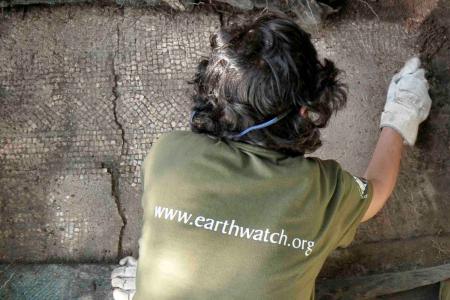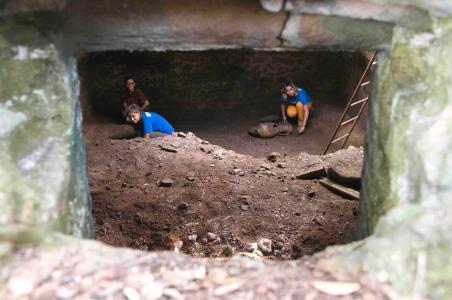Please read the following information carefully before leaving for your expedition.
.
.
Unearthing Ancient History in Tuscany
Expedition Briefing
Quick Navigation: COVID-19 Safety | The Research | Research Aims | How You Will Help | Life in the Field | Accommodations and Food | Project Conditions | Essential Eligibility Requirements | Health and Safety | Project Risks and Precautions | Travel Planning | Additional Resources
Click on the images to view full size!
COVID-19 Safety
You are strongly encouraged to test for COVID-19 before traveling to your expedition, particularly if you are experiencing symptoms. Do not travel if you have tested positive, and call Earthwatch right away for the next steps. Please see earthwatch.org/covid-19 for more information.
The Research
Populonia is one of the most important active archaeological sites in Italy. From 900 BCE to 100 CE, it served as the center of iron smelting and trade in the Mediterranean. Iron was the city’s economic base and source of wealth. The transfer of the city from Etruscan to Roman rule (at about 250 or 200 BCE) did not halt its metalworking activities; iron exports supported Roman expansion in Africa, and the Augustan ruling class (50 BCE to 50 CE) had important economic interests in the area’s industrial production and commerce.
To reconstruct the economic and social history of the city of Populonia, we must understand when iron smelting took place, how society in the city formed around iron smelting activities, the trade routes, and the people who lived and worked in the harbor, mines, and iron-smelting industry.
To achieve these goals, our project aims to continue excavating at the Roman settlement on Poggio del Molino (“Windmill Hill”), the area's most interesting Roman late-republican and imperial site. Poggio del Molino is also the first Park of Shared Archaeology in Italy.
On the north side of the Baratti Gulf, the Settlement of Poggio del Molino is, so far, the most significant site to help us reconstruct the history of Populonia between the 2nd century BCE and the 5th century CE. Focusing the research at Poggio del Molino settlement gives us extraordinary evidence about a dark period in Populonia history.
The excavation of the Roman settlement of Poggio del Molino, the only example of a Roman fortress, farm, and villa in the territory of Populonia systematically investigated, is conducted under the scientific direction of the Aglaia Foundation with Carolina Megale Ph.D. (in agreement with Municipality of Piombino) and the professionals of the Archeodig Project.
The archaeological site extends over the northern and eastern slopes of a promontory that acts as a watershed between the beach of Rimigliano in the north, the Gulf of Baratti to the south, and the northern boundary of the town of Piombino (Livorno).
The Roman structures are located on a plateau about 20 meters above sea level that dominates the stretch of sea between San Vicenzo and the Isle of Elba in the west and the Metalliferous Hills and the plains of Campiglia lagoon to the east.
During the 2nd century BCE, the northern end of the promontory was occupied by a fortified building positioned to defend the territory of Populonia from pirate attacks. Thanks to contemporary sources we know that between the 2nd and 1st centuries BCE, piracy was prolific on the Mediterranean coasts and sea. The fortress’ strategic position allowed control of most of the Tyrrhenian Sea routes, the access to the channel that connects the sea to the lake of Rimigliano, and the southern territory of Populonia.
The building, with a rectangular plan of about 55 x 56 meters, has been investigated in the southeast sector, organized around a porch, where evidence of ironworking has been uncovered. Along the perimeter wall, we have identified two defensive towers erected adjacent to the two entrances of the settlement and a watchtower that allowed communication with Populonia. In 67 BCE, following the issuance of the Lex Gabinia, Gneo Pompeo took command of the war against the pirates of the Mediterranean Sea, over which, in just four months, he reported a total victory.
In the first half of the 1st century BCE, without the threat of pirates, the building was repurposed as a farm with an adjoining 'cetaria', or small home-based factory, producing 'garum' (fish sauce), equipped with pools for soaking the fish, which we can still see today.
Around the middle of the 2nd century CE, after a thorough renovation, the building took on the characteristics of a maritime villa, which was later destroyed around the end of the 3rd century CE, probably by an earthquake. The villa was organized around an open area, set out as a garden, and exploited the same two accesses used in the earlier phases. The western entrance gave access to the main living area (cubicula and dining rooms), decorated with mosaics and frescoes, and to the bath complex via a corridor overlooking the sea. The slave quarters, which are known as the kitchen and other utility rooms, still under excavation, were accessed via the eastern entrance.
In the 4th century, after the destruction, the eastern sector of the complex was reoccupied and used for activities connected with ironworking. In addition to a large amount of iron slag and hematite, a furnace connected with a forge has been documented.
Even in the 5th century, the site experienced a significant phase of inhabitation connected with the presence of a gathering place, probably linked to early Christian worship, and of a tomb set in a wall of the villa ruins.
Today, the top of the hill is occupied by the beautiful Villa del Barone, built in 1923 by Baron Luigi De Stefano and Assunta Vanni Desideri, the daughter of Eugenio. From a paper of the 16th century, the "Bandita di Porto Baratti," and other archival documents, we know that the Poggio owes its name to the mill which was a part of Torre Nuova ("Torre Nuova del Molino"), the building of coastal defense and a lookout built in the early sixteenth century by Cosimo I de' Medici, on the slopes of the promontory.
Unearthing Ancient History in Tuscany
Research Aims
Through our excavations, we aim to fill gaps in our knowledge of the history and coastal economy of the Populonia area from the Etruscan period (beginning in 800 BCE) through the Roman period (beginning at about 250 to 200 BCE) and up to the early Middle Ages (at 600 CE). Our results will help illuminate how the Etruscan and Roman economies operated and how the Romans exploited the natural resources of the territories they ruled. We still know very little about the political, economic, architectural, and religious changes brought by the arrival of the Romans in this part of the Etruscan coast.
Our findings can inform educational programming, conservation techniques, and excavation methods, which will help preserve these sites for future generations. Archaeological sites in the Bay of Populonia-Baratti face threats from treasure hunters and looters, and we aim to use our findings to show the public the great cultural value of protecting these historic sites. We also provide a rare opportunity for young people to gain professional experience. It is very difficult to enter the field of archaeology in Italy, and by giving local and international students internships and jobs, we can help them enter the field and continue the research that we believe is so important.
Unearthing Ancient History in Tuscany
How You Will Help
You will help us reconstruct the area’s complex past as fully as possible. All teams will excavate the Roman settlement of Poggio del Molino. If weather prevents work outside, you’ll help reconstruct the shapes of excavated objects by trying to rebuild the original from the fragments collected, draw, record, and analyze data.
- Archaeological Excavation and Technical Relief: Collecting samples after removing the earth from them with specialized tools and taking the earth away by wheelbarrow. Drawing of plans, sections, etc.
- Recording and Analysis: Cleaning, marking, listing, drawing, and cataloging mobile artifacts. Geological analysis of stone building material.
- Conservation and Restoration: Pottery, reconstruction of shapes, drawing. Wall and pavement decoration, drawing, and preliminary conservation operations.
- Cultural Dissemination: Demonstration of the archaeological activity on-site to the general public. Contribution to periodical reports, both in print and on the website.
- Active and Passive Protection: Temporary protection of site; housing of artifacts; planning of definitive protection of the site.
Unearthing Ancient History in Tuscany
Life in the Field
Once here, you’ll watch presentations and practical demonstrations to prepare for fieldwork. Staff members will always be available to clarify anything and help where necessary. You’ll also learn about our research and the methodology (such as the stratigraphic method) through staff talks throughout the expedition, which may happen in free afternoons or evenings. Most days, you’ll have time to relax in the early evening, just before dinner. NOTE: You are welcome to help with meal preparation, and you will be required to assist with table setting and cleaning up after meals. Other students and volunteers will work on the sites, but the Earthwatch volunteers will work in separate groups.
DAILY SCHEDULE
Weather and research needs can lead to changes in the daily schedule. We appreciate your cooperation and understanding.
Note: Punctuality is important, as the project has fixed schedules. Please plan to meet the team promptly every morning.
- 8:00 a.m.: Breakfast
- 8:30 a.m.: Meet on-site and daily briefing
- 8:45 a.m.–1:00 p.m.: Work on site
- 1:00–2:00 p.m.: Lunch
- 2:00–5:00 p.m.: Work on site
- 5:15 p.m.: Return to the accommodations
- 5:30–7:30 p.m.: Recreational time
- 8:00 p.m.: Dinner
- 9:00 p.m.: Downtime
Those joining the project for 13 days will have one full recreation day. All teams will attend evening lectures, and a wine tasting may be organized (at the volunteers’ own expense) on one evening.
ITINERARY
FOR 7-DAY TEAMS (A & B)
- Day 1: Rendezvous and travel to accommodations. Welcome.
- Days 2–6: Health and safety briefing, lectures, updates, and work on-site. Excavation, survey, and other research tasks as detailed above.
- Day 7: Tidy up and departure
CONTINUATION FOR 13-DAY TEAMS
- Day 7: Recreational day: visit to the Medieval Castle of Populonia
- Days 8–12: Excavation, survey, and other research tasks as detailed above
- Day 13: Tidy up and departure
RECREATION DAY: VISIT ANCIENT AND MEDIEVAL POPULONIA (13-DAY TEAMS)
- 10:00 a.m.– 1:00 p.m.
- Visit the city historical center of Piombino
- 1:00 p.m.–2:00 p.m.
- Lunch
- 3:00–4:30 p.m.
- Visit the medieval castle and village of Populonia
- 6:00–8:30 p.m.
- Recreational time
- 8:30 p.m.
- Dinner
Unearthing Ancient History in Tuscany
Accommodations and Food
* Please note that not every expedition has couples or single accommodations available. Please call or email Earthwatch to check availability before reserving your space(s) on the team.
Teams will stay at the Populonia Stazione Resort. The accommodations feature modern furnishings, television, single beds, and gas heat. Each apartment has a small kitchen with a stove, dishwasher, and fridge. Apartments vary in size according to team size.
SLEEPING
Same gender rooms are assigned with two to three volunteers per room. Single rooms* and couple rooms are subject to availability and will depend on numbers and the gender makeup of the team. Please request this when booking and note it on your volunteer forms.
Towels and bed linens are provided. If you are particularly susceptible to feeling chilly during the night, bring warm pajamas and/or a light sleeping bag.
*Single rooms can be guaranteed for the additional cost of €400 per week, payable to research staff upon arrival. If interested, you must inform Earthwatch of this request at least 45 days before the start of your team.
* Earthwatch will honor each person’s assertion of gender identity respectfully and without judgment. For both teen and adult teams, where logistics dictate single-sex accommodations or other facilities, participant placements will be made in accordance with the gender identity the participant specified on their Earthwatch Participant form and/or preferences indicated in discussions with Earthwatch.
BATHROOMS
Participants will be assigned a private bathroom per room, with hot showers and flush toilets.
ELECTRICITY
You are welcome to bring electrical equipment. Electrical outlets are 220 Volts, 50 Hz, standard European plug.
PERSONAL COMMUNICATIONS
Wireless Internet is available at the resort courtyard and restaurant but is less reliable in individual rooms. Computers/tablets aren’t available, so you must bring your own electronic devices. If you wish to call home, a public telephone box is available, and if you inform the staff at the start of the project, they can take you to purchase an international calling card.
Please note: Earthwatch encourages volunteers to minimize outgoing calls and immerse themselves in the experience; likewise, family and friends should restrict calls to urgent messages only. Emergency communications will be prioritized.
FOOD AND WATER
You’ll enjoy typical Italian-style cuisine on this expedition. You’ll help yourself to breakfast at the accommodations in the morning from a selection of the foods listed below, which may vary slightly from day to day.
Whenever possible, lunch will be enjoyed in the field as a packed lunch, in addition to some mid-day refreshments.
There is drinking water available on-site at the accommodations. There will also be juice, tea, and coffee at the accommodations.
Dinner will be at the resort restaurant and is eaten later in the evening in Italy (between 8–9:00 p.m.); there will be biscuits and fruit available to snack on, but if you wish to have more snacks when you return from the field then you will need to bring some or purchase them from the small supermarket.
TYPICAL MEALS
The following are examples of foods you may find in the field. Variety depends on availability. We appreciate your flexibility.
- Breakfast: Yogurt, fruit, cereals, bread, sweet snacks, biscuits, croissants, tea, coffee, and juice
- Lunch: Rice or pasta dishes, sandwiches, and fruit
- Dinner: Varieties of meat, fish, pizza, pasta, with vegetables and salad accompaniments and dessert
- Snacks: Biscuits/cookies, fruit
- Beverages: Water, coffee, tea, juices
SPECIAL DIETARY REQUIREMENTS
Please alert Earthwatch to any special dietary requirements (e.g., diabetes, lactose intolerance, nut or other food allergies, vegetarian or vegan diets) as soon as possible and note them in the space on your volunteer forms.
Accommodating special diets is not guaranteed and can be very difficult due to the availability of food, the location of field sites, and other local conditions.
Unearthing Ancient History in Tuscany
Project Conditions
The following information is as accurate as possible, but please remember that conditions may change.
At the site, the ground is flat and open; shade will be provided. It will likely be dry most of the time, but if it does rain, the ground can become very slippery.
GENERAL CONDITIONS
Please visit Wunderground.com and search for your project location for weather and region-specific information.
Unearthing Ancient History in Tuscany
Essential Eligibility Requirements
Note: Excavation requires constant hard work; participants may find this very strenuous. We strongly recommend that you undertake some training (walking, carrying, bending) to strengthen your fitness level before joining the project.
All participants must be able to:
- Enjoy being outdoors all day; maintain a good team attitude in all types of weather and the potential presence of insects.
- Tolerate temperatures listed above and often hot and humid conditions; shade is provided, but the sun and humidity cannot be avoided entirely.
- Kneel, sit, or get low enough to the ground to carry out excavation activities comfortably for 2 to 5 hours per day.
- Regularly get oneself up and down from the ground during excavation tasks for 2 to 5 hours a day, which can potentially cause strain on the back and knees. If required, there will be the opportunity to work from chairs during pottery lab activities.
- Traverse over rough, uneven terrain (often wet and slippery), low-lying walls, and steep slopes with no handrails while on the excavation sites.
- Tolerate occasionally dusty conditions while working, which, combined with a breeze, can sometimes be uncomfortable for contact lens wearers. Wearing glasses may be more comfortable.
- Traverse over uneven and often steep terrain for up to three hours if partaking in optional recreational walking trips to see surrounding areas.
- Get yourself up and down from a vehicle and ride, seated with a seatbelt fastened, for approximately two hours.
- Follow verbal and/or visual instructions independently or with the assistance of a companion.
- Take an active role in one’s safety by recognizing and avoiding hazards if and when they arise (including, but not limited to, those described in Earthwatch materials and safety briefings). Comply with project staff instructions and recommended safety measures at all times.
- Effectively communicate to the staff if they are experiencing distress or need assistance.
- Be able to get along with a variety of people from different backgrounds, often in close proximity, for the duration of the team.
- Be comfortable being surrounded by a language and/or culture that is not your own.
- Take an active role in your safety by recognizing and avoiding hazards if and when they arise (including, but not limited to, those described in Earthwatch materials and safety briefings). Comply with project staff instructions and recommended safety measures at all times.
Unearthing Ancient History in Tuscany
Health and Safety
EMERGENCIES IN THE FIELD
A large, well-equipped hospital is approximately 20 minutes away from the site. We would transport the injured party to the hospital in a project vehicle or by ambulance in an emergency. There is a place to land a helicopter near the site and a helipad at the hospital. Minor injuries will be treated on-site with basic first aid.
Earthwatch has a 24-hour, 7-day-a-week emergency hotline number. Someone is always on call to respond to messages that come into our live answering service.
IMMUNIZATIONS & TRAVEL VACCINATIONS
Please be sure your routine immunizations are up to date (for example, diphtheria, pertussis, tetanus, polio, measles, mumps, rubella, and varicella) and that you have the appropriate vaccinations for your travel destination. Medical decisions are the responsibility of each volunteer and their doctor. Visit the Center for Disease Control and Prevention or the World Health Organization for guidance on immunizations.
If traveling from countries or regions where yellow fever is endemic, you must have a certificate of vaccination.
It is strongly encouraged that you stay up to date with your COVID-19 vaccinations, including receiving booster doses, as applicable.
Unearthing Ancient History in Tuscany
Project Risks and Precautions
TRANSPORTATION
As in any country, transport is a risk. All minibusses and cars will be fitted with seatbelts, and all passengers must wear them whenever the vehicle is in motion. Only experienced drivers will drive vehicles. Each vehicle will contain a first-aid kit and a cell phone for communication.
Participants may not drive, even their own cars, during the project.
WALKING/ TERRAIN
The terrain may be rough and can become very slippery when wet. Appropriate footwear with good traction and steel-capped toes (required by the Italian government) must be worn. Do not run on-site, and be aware of where you walk. Walkways must remain clear; do not leave tools, equipment, or personal bags in places that could create a hazard for others. You may not park wheelbarrows, walk close to, or sit on the edge of the work pits. Metal grid pegs with orange caps mark areas on the site where you may not walk. During site planning, we stretch a red and white string between the grid pegs at approximately three to six inches (eight to 15 centimeters) above the ground, which creates a trip hazard you should be cautious of. You will not be permitted on site without staff. The terrain of the villa research site is rough and uneven and presents a significant risk of tripping and falling if care is not taken.
STRAINS AND SPRAINS
Wear sturdy footwear, long socks, and trousers on site. Also, pay attention to your abilities and work within your limits. You may want to use gloves and kneeling pads. We will instruct you not to overfill buckets and wheelbarrows and teach you the correct procedures for lifting heavy objects. Ask for assistance when moving large items. When lifting rocks or stone blocks, take care not to trap your fingers. We will instruct you to wear a helmet if you’re working underground at the site.
ANIMALS / PLANTS
- Scratches from Vegetation. Again, watch where you walk and wear long-sleeved tops, long pants, and gloves to avoid scratches. You must have an up-to-date tetanus vaccination.
- Mosquito Bites. There are many mosquitos around the site and accommodations; with them, there is the danger of infection and disease. Bring mosquito repellent and wear long pants and sleeves to avoid bites, especially in the evening.
- Wildlife. Do not approach harmful animals; let field staff remove them safely. Although vipers are rarely seen, do not go off paths into the surrounding woods. Because of spiders and scorpions, take care when moving stones, choosing a place to sit on the ground, and putting on shoes. Some hairy caterpillars on the surrounding pine trees may cause a rash.
- Hay fever. Plants at the sites may cause hay fever in those susceptible to it. Bring any appropriate medication and tissues to the field.
CLIMATE / WEATHER
- Sun exposure Please wear high SPF sunscreen, a sun hat, and lightweight long-sleeved clothing, and rehydrate regularly with water, which is freely available on site. Some shade will be available on site.
PROJECT TASKS/ EQUIPMENT
- Eye irritation/ infection. Excavation will stir up dust and grit, which can cause infection or discomfort to the eyes. Although everyday eyewear provides some protection, safety glasses will be available, and instructions will be given regarding keeping eyes safe.
- Injury from tools. Volunteers will be instructed in the correct use and safe storage of tools. Staff will supervise the use of tools, and volunteers must listen carefully to instructions.
- Damage to the excavation site. We will demonstrate the correct excavation methodology and remind you not to walk, sit, or leave belongings on the ancient walls and artifacts, which could cause long-term damage. Always listen carefully to instructions.
PERSONAL SECURITY
- Theft. Petty crime is common in cities. Keep your wallet, purse, valuables, passport, and other travel documentation secure while passing through stations and airports. There is a small risk of petty theft on-site, as members of the public occasionally pass through, so we will ask you to store your bags in a safe place. Keep valuables locked up or in your possession at all times. The accommodations will be locked when we leave for the day.
SWIMMING
We will brief you on the risks of swimming in the sea, and only confident swimmers should enter the water. You may not swim in bad weather. Staff will assess and approve all swimming sites daily. Swimming alone or after drinking is not permitted.
DISTANCE FROM MEDICAL CARE
20 minutes by car
RISK OF COVID-19 OR OTHER RESPIRATORY ILLNESS
Earthwatch strongly encourages you to take precautions to help protect yourself and others from common viral respiratory illnesses, including COVID-19, flu, and RSV: stay up to date with your vaccinations; wash your hands frequently; take steps to improve air quality, for example, by increasing ventilation indoors or gathering outdoors; and use preventative measures to limit the spread if you are sick.
Persons with a higher risk of severe respiratory illness should consult their healthcare provider before participating.
Unearthing Ancient History in Tuscany
Travel Planning
RENDEZVOUS LOCATION
Campiglia Marittima train station, Province of Livorno, Italy
* Earthwatch will provide additional information to meet your team. Please do not book travel arrangements such as flights until you have received further information from Earthwatch.
ABOUT YOUR DESTINATION
Earthwatch strongly recommends that travelers investigate their destination before departure. Familiarity with the destination’s entry/exit requirements, visas, local laws, and customs can ensure smooth travel. The U.S. Department of State's Traveler’s Checklist and Destination Guides are helpful resources. For LGBTI travelers, the U.S. Department of State's LGBTI Travelers page contains many helpful tips and links.
COUNTRY AND PROJECT ENTRY REQUIREMENTS
You are responsible for reviewing and abiding by your destination's entry/exit requirements.
Entry visa requirements differ by country of origin, layover, and destination and do change unexpectedly. For this reason, please confirm your visa requirements at the time of booking and again 90 days before travel. Please apply early for your visa (we recommend starting six months before the start of your expedition). Refunds will not be made for volunteers canceling due to not obtaining their visa in time to meet the team at the rendezvous. You can find up-to-date visa requirements at travisa.com.
If a visa is required, participants should apply for a TOURIST visa. Please note that obtaining a visa can take weeks or even months. We strongly recommend using a visa agency, which can both expedite and simplify the process.
Generally, passports must be valid for at least six months from the date of entry, and a return ticket is required.
Unearthing Ancient History in Tuscany
Resources
BOOKS
- S. Monti, C. Megale, Quanto l’archeologia diventa un’opportunità per disegnare il futuro / How much archaeology becomes an opportunity to design the future https://riviste.unimc.it/index.php/cap-cult/article/view/2196
- C. Baione, Communicating archaeology to everyone, https://www.tafterjournal.it/2021/03/16/communicating-archaeology-to-everyone-the-poggio-del-molino-archaeological-site-virtual-approach/
- C. Megale, A. Camilli, E. Sorge (a cura di), Archeologia in cantiere. Nuove scoperte dagli scavi di Baratti, Pisa 2014. Online https://unifi.academia.edu/CarolinaMegale.
- Green, Kevin. Archaeology: An Introduction. London: Routledge, 2010.
- Renfrew, C and P. Bahn, Archaeology: Theories, Methods, Practice. London: Thames & Hudson, 2006.
- Megale, Carolina. Fare l’Archeologo per Passione e per Mestiere. Livorno: Books & Company, 2009. Online https://unifi.academia.edu/CarolinaMegale.
FIELD GUIDES
- C. Megale, S. Genovesi, The Roman Settlement of Poggio del Molino: the Late Republican Fort and the Early Imperial Farm of Poggio del Molino. Preliminary data, FOLD&R, n. 347, 2016.
- C. Megale, S. Genovesi, Economy and production in Late Republican Settlement of Poggio del Molino, Populonia, in L. Bombardieri, A. D’Agostino, G. Guarducci, V. Orsi, S. Valentini (a cura di), Identity and Connectivity: Proceedings of the 16th Symposium on Mediterranean Archaeology, Florence, Italy, 1–3 March 2012, BAR International Series 2581 (II), 2013, pp. 901-908.
- Archaeological Guide to the Province of Livorno and the Tuscan Archipelago. Florence: Nardini Editore, 2003.
- Semplici, Andrea. Baratti and Populonia Archaeological Park. Florence: Fotolito Toscana, 2008. Note: This guide is only available on-site; Carolina has a copy.
FILMS/DOCUMENTARY
- https://www.youtube.com/watch?v=OrFliPGCNFQ
- https://www.youtube.com/watch?v=RxHrkthprUQ&t=138s
- Roman Archeology: Myth and Reality—Part One: Rome and the Etruscans Between minutes 15 and 20 of this documentary on archeology, you’ll see footage of the project site and Carolina discussing it.
PROJECT-RELATED WEBSITE
Unearthing Ancient History in Tuscany
Sign up for the Earthwatch Newsletter
Be the first to know about new expeditions, stories from the field, and exciting Earthwatch news.
.
.
